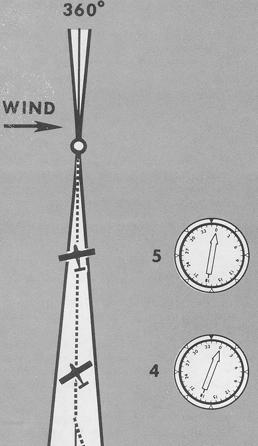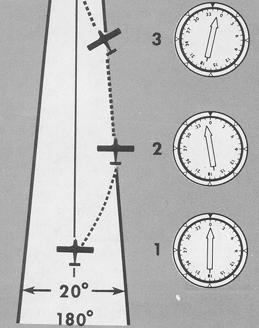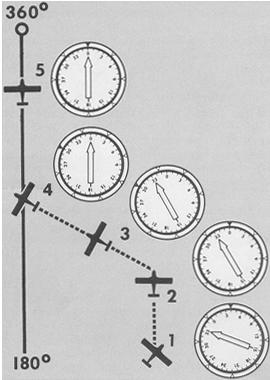

A brief description of the RMI was given earlier in this handbook
on page 52. This section covers RMI procedures as they relate to tracking
a course and intercepting a course. The procedures given are similar to
those previously described on pages 136 through 138 using the CDI. In the
RMI illustrations, only the double-barred bearing pointer is displayed.
Tracking a Course. Follow these steps (Fig. 8-16) when tracking
inbound. A similar procedure is used when tracking outbound.
1. Your heading is 360°, you are on the 360° course (inbound
on the 180° radial), and the bearing pointer indicates 360°.
2. As you maintain a constant heading of 360°, the bearing
pointer indicates you have drifted off course approximately 10° to
the right. This indicates a left crosswind component.
3. Turn left 20° to a heading of 340°.
4. The aircraft has returned to course and the bearing pointer
again indicates 360°. If you maintain the present heading of 340°
you will fly through the course. If you return to the original heading
of 360°, you will drift off course to the right again.
5. Reduce the drift correction to 10° left. The aircraft
heading is now 350°. This correction may hold the desired course, or
it may be too small or too large. If the course is not maintained, further
bracketing will be required.
Intercepting an Inbound Course. Follow these steps (Fig. 8-17) when intercepting an inbound course. A similar procedure is used when intercepting an outbound course. The first three steps may be omitted if you turn directly to the interception heading.
1. Determine the inbound course to be intercepted, then turn
to a heading that parallels it. In this example, the 360° course is
to be intercepted.
2. After paralleling the inbound course, note the deflection
of the bearing pointer. In this example, the deflection is 30° left.
Figure 8-16. VOR tracking with RMI.
 |
|
 |
Figure 8-17. VOR course interception with RMI.
 |
3. Double the number of degrees deflection to determine the interception
angle. The angle should not be less than 20° nor greater than 90°.
Turn to the interception heading. In this example, it is 300°.
4. Hold the interception heading until the bearing pointer indicates
the desired course, 360°. At this point you have intercepted the course.
5. Turn to the desired course (this turn should be started before
reaching the course unless the rate of interception is very slow).